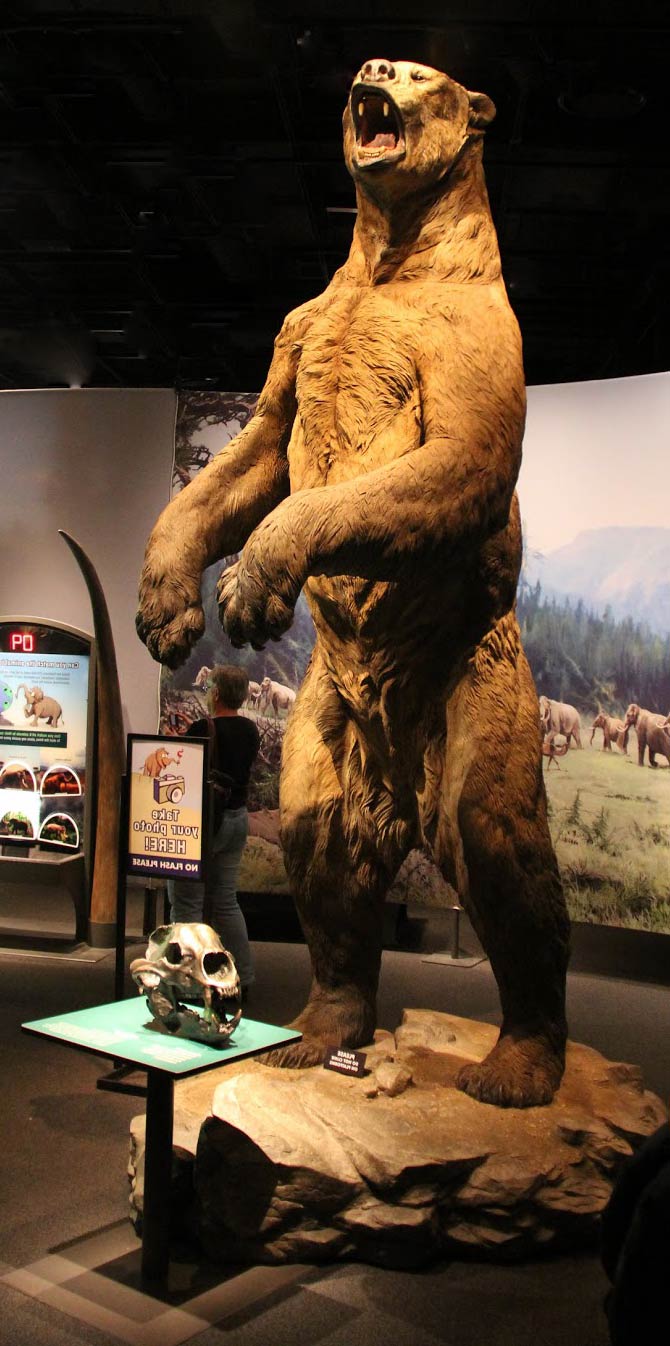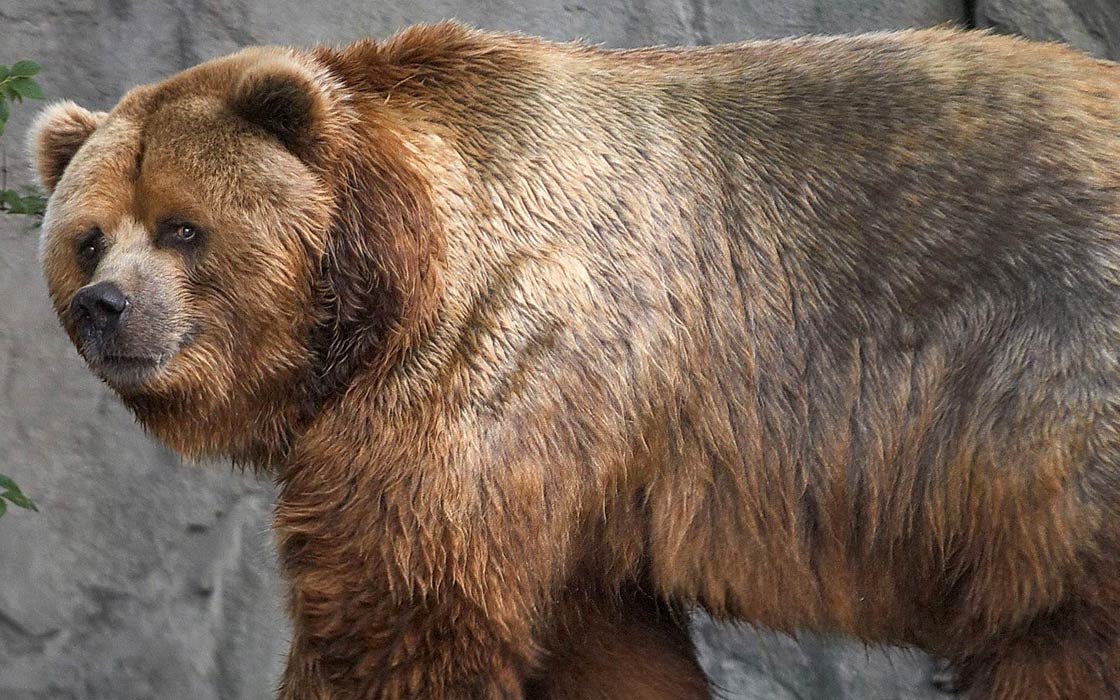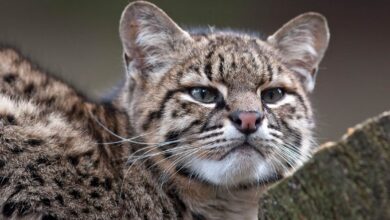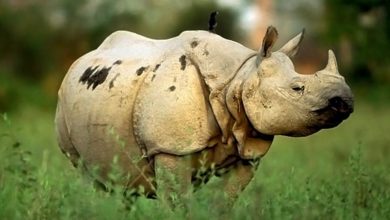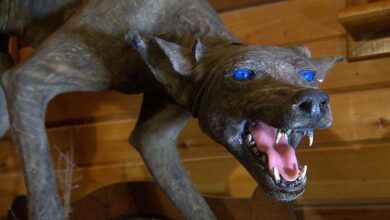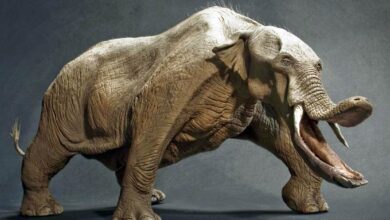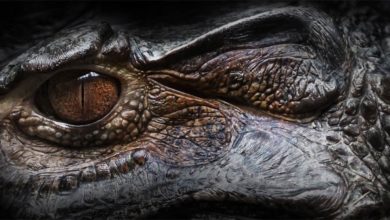Giant short-faced bear (Arctodus simus)
An animal that, standing on two legs, could reach the first floor. It could be as fast as the best modern racehorses, and with physical strength and charisma, it was able to defeat the saber-toothed tiger or the American lion. It was believed to be one of the largest predatory mammals that lived on Earth during the Ice Age. However, some early giant carnivorous mammals such as Andrewsarchus, Sarkastodon, and Megistotherium appear to have been similar or even larger. Was a short-faced bear the perfect killing machine?
Classification
- Kingdom: Animalia
- Phylum: Chordata
- Class: Mammalia
- Order: Carnivora
- Family: Ursidae
- Subfamily: Tremarctinae
- Genus: †Arctodus
- Species:
- †Arctodus pristinus
- †Arctodus simus
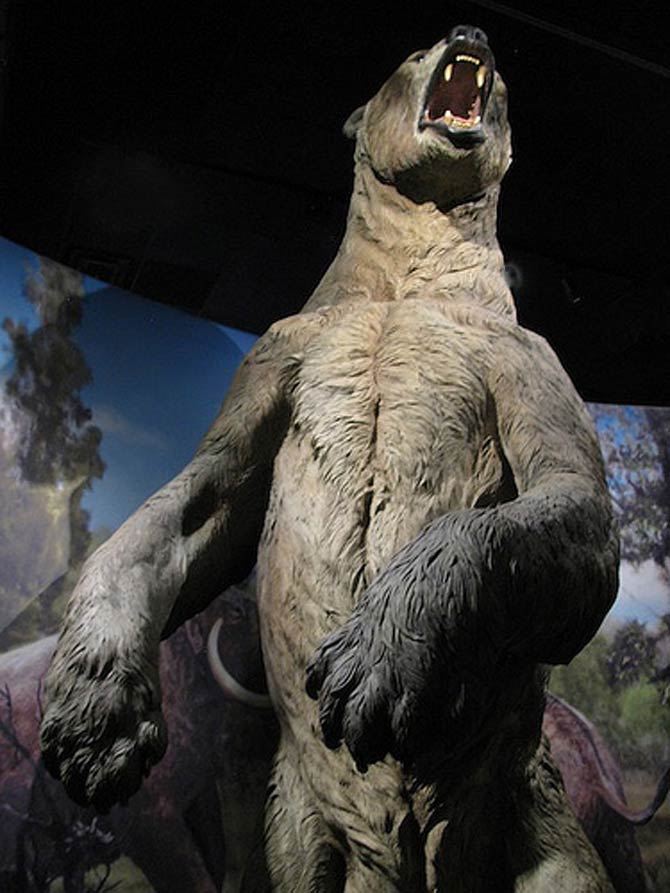
Occurrence and dating
This prehistoric giant inhabited North America in the Pleistocene epoch from approx. 1.8 million to approx. 11 thousand years ago. At that time, the most abundant brown bear population was located in what is now California. So far, 2 species have been classified:
- Arctodus simus
- Arctodus pristinus
The former is considered to be one of the largest known predatory land mammals, and for many years the largest bear ever discovered. Stop – was it the largest for sure? About this in a moment.
The species Arctodus pristinus lived in the south of the continent, from Texas in the north to Mexico in the south. Most of its skeletons have been found in the state of Florida. Unlike its larger relative, it appears to have preferred coastal forest formations.

Characteristic
Appearance
The species Arctodus simus appeared about 800,000 years ago from Alaska to the Mississippi. It died out about 11,600 years ago. Its fossilized remains have been found at several paleontological sites in California. The largest, almost fully preserved skeleton of the Arctodus simus bear was discovered in Indiana. The original skeleton is in the Field Museum in Chicago, while museums in Indiana, Indianapolis, and Canada have casts of it.
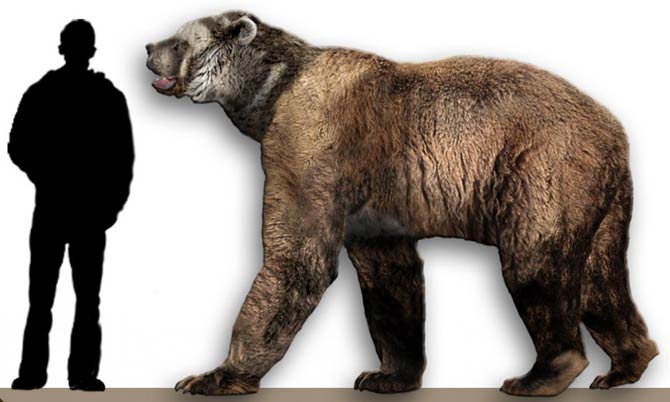
Size
Based on numerous finds, it has been estimated that the short-faced bear of the species Arctodus simus weighed about 900 kg (1984 lb), although some scientists say that its weight exceeded one ton. Standing on the hind legs, it could reach 2.4-3 m (7.9 – 9.8 ft) in height, and the largest specimens could even be 3.4-3.7 m (11.2 – 12.1 ft). The height at the withers was 1.5-1.8 m (4.9 – 5.9 ft), which means that the average short-faced bear standing on four legs could meet a man’s eyes.
At the paleontological site in Missouri – Riverbluff Cave – traces of bear claws at a height of 4.57 m (15 ft) were found, which suggests that the said individual may have been about 3.65 m (12 ft) high. The typical reach of the arms in a bipedal position is estimated at 4.3 meters (14.1ft).
Although the species Arctodus simus was taller than the modern grizzly bear, it had a lighter build, longer and slender limbs, and forward-pointing toes. All these features allowed it to develop dizzying speeds (50-70 km/h).

Long legs
If we take a closer look at the hero of our today’s article, we will notice an unusual feature for a bear – very long limbs …
Short torso
… and a relatively short torso. Of course, the muzzle was also very short, hence its name 🙂
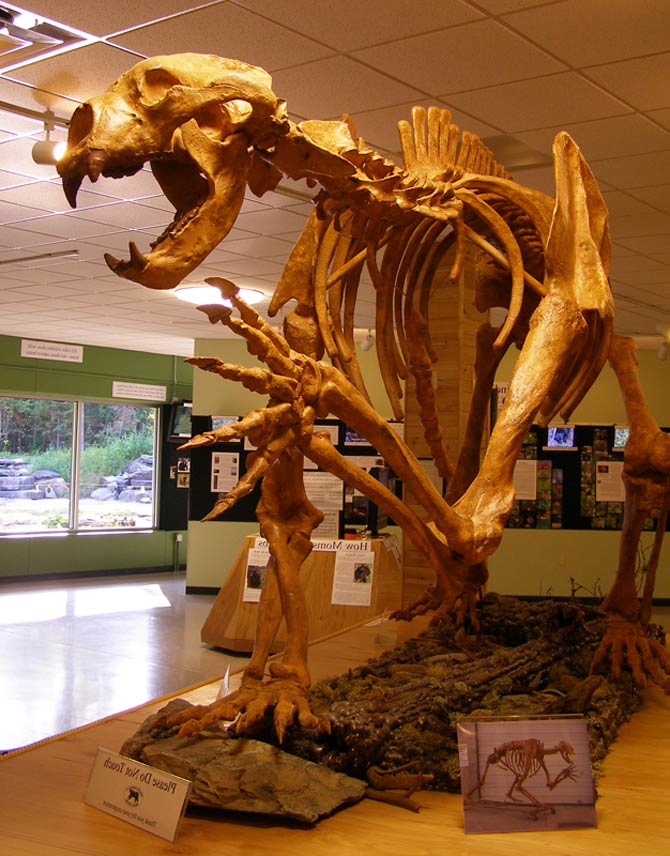
Eating habits
The shape of the skull and teeth indicate a typically carnivorous animal. The eye sockets were set wide apart, in front of the mouth, which allowed him a wide field of view. The short, wide snout was equipped with a huge nose, probably very sensitive to the smell (useful for sensing not only victims, and threats but also carcasses). In addition, the animal would be able to take up copious amounts of oxygen while chasing prey.
The jaws, wide in relation to their length, were equipped with large teeth suitable for cutting meat, crushing bones and sucking the marrow. Moreover, based on analyzes of stable nitrogen isotopes in the bones (high concentration of nitrogen-15), it was shown that the short-faced bear, unlike modern American bears, ate only meat.
However, it is difficult to say whether it was an active predator or rather a scavenger. One theory is that it stole prey from smaller predators such as wolves, smilodons and American lions.
The smaller species Arctodus pristinus had a longer snout and was rather omnivorous.
Or maybe omnivorous after all?
The scientific world is generally divided over the short-faced bears’ diet. There are voices that they were omnivorous like the bears that live today. Bears consumed plants when meat was not available.
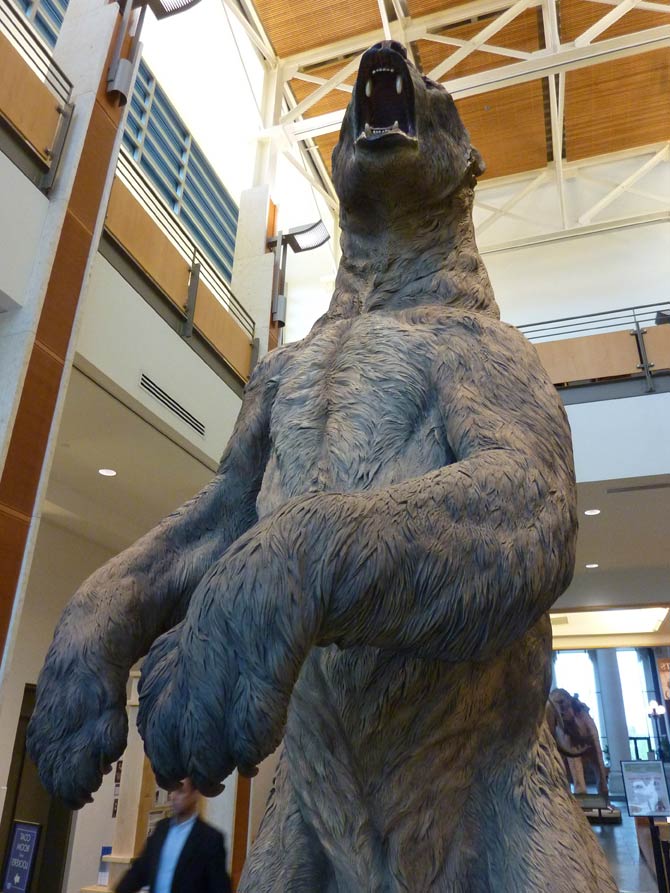
Hunting skills
According to one theory, the short-faced bear was a quick, strong and cruel killer hunting large herbivorous mammals of the time (including wild horses, and antelopes). It is possible that despite its enormous size, its slender limbs might have allowed for a hunting strategy based on the pursuit. Although it was able to reach speeds of 50-70 km/h (31 – 43.5 mph), it was not very maneuverable, so it could not cope with catching an agile herbivore.
Paleontologist Paul Matheus determined that the short-faced bear moved more like a camel, horse and modern bear, which would testify not to its speed but to its endurance. On the basis of numerous simulations, Matheus concluded that it could not be an active hunter, but rather a kleptoparasite – a predator that steals food from other predators.
In theory, it could afford it – which animal would dare to oppose a thief the size of a short-faced bear? Through intimidation, it could get food from smilodons, dire wolves (Canis dirus / Aenocyon dirus), and even American lions. This is a somewhat similar strategy that is often attributed to large predatory dinosaurs (T. rex, Tarbosaurus, etc.).
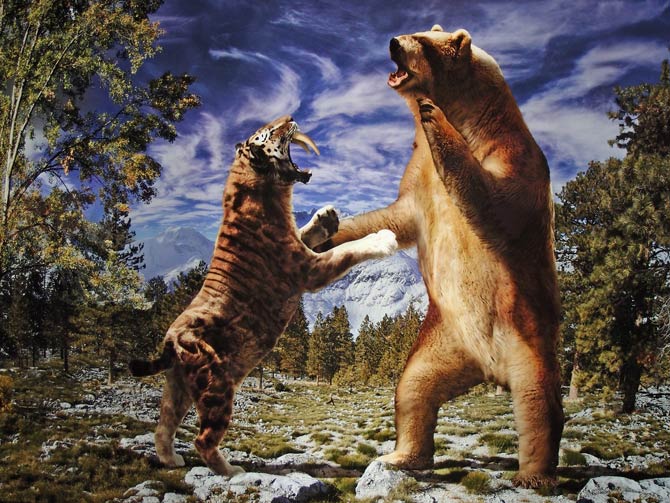
Is the short-faced bear the biggest bear of all time?
Although it was originally believed to be so, the latest discoveries do not fully confirm this thesis. So which bears were bigger?
Arctotherium angustidens
It is a species of bear of the genus Arctotherium that was found in South America during the Pleistocene 1.2 million years ago. According to the data we have, its weight was estimated on the basis of the humerus in the range of 983 – 2,042 kg (2167 – 4502lb); average of 1,588.5 kg (3,502 lb), and the median at 1,748.6 kg (3,855 lb). The upper limit (over 2 tonnes) is likely to be overestimated. Its closest relative was the North American short-faced bear (the hero of our today’s article).
In truth, it was Arctotherium angustidens who came to South America from North America to begin its reign there – apparently, North America was too tight for it and the competition (lions, smilodons, bears, dire wolves) was too great. Interestingly, unlike its North American cousin, it tended to shrink in size.
Ursus maritimus tyrannus
Little is known about it, as it is known for one fragmentary bone found in the Thames. Its size has been estimated at 3.6-3.9 meters (11.8 – 12.8 ft) in an upright position, and its weight was between 1200 and 1500 kg (2646 – 3307 lb). Originally thought to be related to the polar bear, it is now believed that the brown bear is related to it.
However, we have to admit that the discrepancy in weight estimates for both bears is quite large depending on the source.
Cave bear (Ursus spelaeus)
It occurred in Europe, its bones were also found in Poland (in the famous Bear’s Cave in Kletno). However, it was not as large as its cousins.

Detailed data / dimensions (size)
Short-faced bear (Arctodus simus)
- Body length: 3 m (9.8 ft)
- Height at the withers: 1.5-1.8 m (4.9 – 5.9 ft)
- Vertical height: 2.4-3 m (7.9 – 9.8 ft)
- the largest known specimens were 3.4-3.7 m (11.2 – 12.1 ft)
- Weight: 600-900 kg (1,323 – 1,984 lb), maybe more than 1000 kg (2,205 lb)
- the largest individual found (UVP 015) was estimated at 957 kg (2,2110 lb)
- Speed: 50-70 km/h (31 – 43.5 mph)
- Nutritional requirement: 16 kg (35 lb) of meat per day
- Dating: 1.8 million – 11.5 thousand years ago (Pleistocene). The last tracks found, indicate the date of extinction – 9,530 BCE – see: History of Species Extinctions
- Distribution: North America

Short-faced bear – interesting facts
- The name Arctodus comes from the Greek words meaning “bear’s tooth”.
- The short-faced bear is recognized as the fastest-running bear of all time.
- The short-faced bear was the largest carnivore in North America during the Ice Age.
- The only living relative of the short-faced bear is the Andean bear (Tremarctos ornatus), living in the mountains of South America.
- In Kamchatka, the local hunters believe in the existence of a gigantic bear, which they call Irkulyen (holy bear) and which, according to speculations by zoologists Paul Ward and Stan Bergman, could possibly have dimensions similar to Arctodus simus. However, it is precisely from this area that the largest Eurasian brown bears are known, which are almost the size of the North American Kodiak bears, and there are no bones found from short-faced bears outside of America, which is why these are more likely to be a few oversized specimens of the brown bear.
